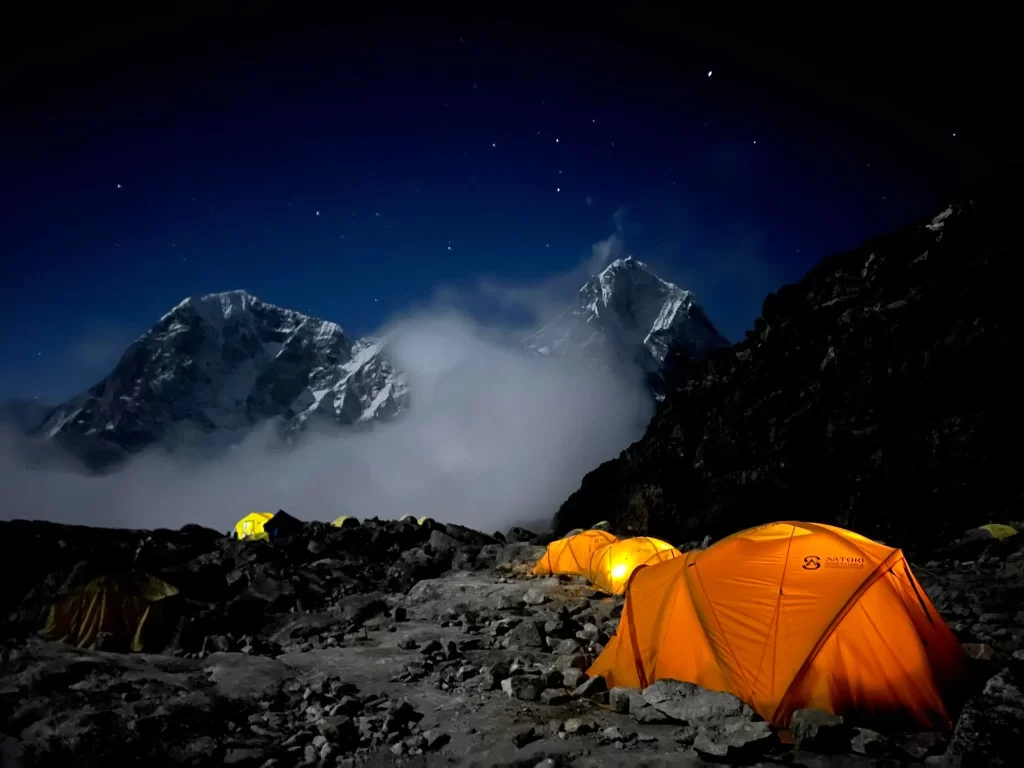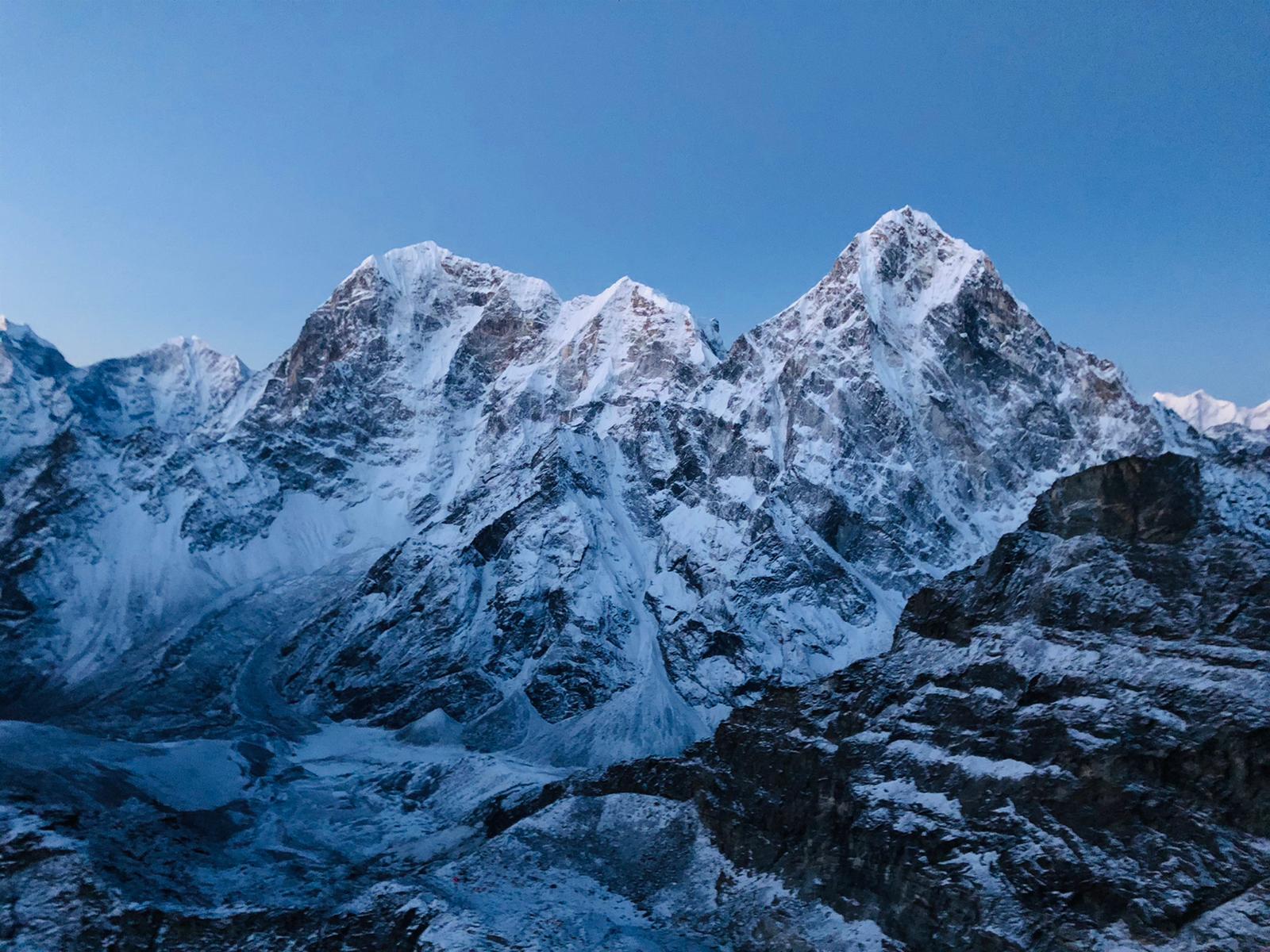Mt. Everest and Preparation
Reaching the top of Mt. Everest is far more than just a climb. It is a meaningful journey which demands precise arrangements and tireless focus. For the journey to the top of the world, it demands strong physicality, a positive mentality, and should be equipped with high-level climbing equipment.In this blog we will be guiding you through preparation for Mt. Everest Expedition.
Challenges & Preparation for Everest Expedition
Proper preparation takes you from defeat to success. Mt. Everest, located at 8,848 meters (29,028 feet), is known as the most demanding ascent point for mountaineers worldwide.The Everest expedition in Nepal is not only climbing; it is a test of your physical strength, technical knowledge,mental and detailed preparation.The Everest expedition lasts around two – three months. The team will proceed to base camp, which is about 5,200 meters, and then advance through the death zone above 8,000 meters, where they will face hazardous conditions, including temperatures around -40°F, changing weather, and ongoing dangers such as avalanches, crevasses, and altitude sickness. Strength, focus, and willpower are a must for a successful journey.

Physical Training for Everest (Building Strength and Endurance)
For any successful expedition, solid planning is necessary. Training for Mt. Everest is like preparing for something challenging or a marathon. It’s a process of building yourself for all kinds of fitness that can withstand high altitude or difficult situations during expeditions where there will be heavy loads and minimal recovery.
Some well-structured Everest training plans should begin at least six to twelve months before the expedition.
Cardio Training
- Running, climbing stairs, and hiking with 30–40 pounds on your back will make you cardiovascularly fit, physically and mentally ready.You should do 4–5 running sessions each week, gradually increasing the duration per session.
- Slow and Steady Session:Training sessions should be steady rather than fast-paced. Focusing on maintaining a consistent pace will help you on the mountain.
- Aim around 8-10 hours of endurance activity every week to build cardiovascular strength and stamina for the long days on the hills.
Strength & Flexibility
- Leg exercises, such as squats and lunges; core workouts, like planks; and upper body strength exercises, like pull-ups, should be considered. Strong legs give you stability on technical terrain, as well as power for the steep sections.
- Perform three to four sets of 12–15 repetitions, twice a week, at a high but achievable weight, while maintaining proper form for best results. Additionally, make time for yoga to gain added flexibility and control over your breath, which is essential for high-altitude climbing.
Altitude Simulation
- If possible, before departure for the expedition, try to train at high altitudes (8,000 feet or higher), or use altitude masks to simulate the same environment.
- Your body should be acclimatized for high altitude treks for expeditions or many days treks . Trek to Everest Base Camp is an excellent acclimatization experience and mental preparation which helps you to counter with altitude effects and difficulty conditions which may occur during the time of expedition.
Mental Preparation: Develop a Summit Mindset
Physical fitness will get you to base camp. Mental strength can be the difference between giving up and reaching the summit. Here are key strategies to develop mental toughness for Everest, a state of mind that allows you to stay focused, positive, and determined in the face of extreme challenges:
- Visualization Techniques: These help you face and conquer obstacles at Everest including storms, exhaustion, and fear, through frequent mental practice. The mental practice enables you to handle reality’s challenges with calmness and focus.
- Stress management: Practice daily meditation by building mindfulness habits because they will help you maintain focus and control your anxiety. These skills will help you survive during dangerous situations or while waiting out storms in your tent for days.
- High-altitude conditioning: Train yourself by putting yourself in extreme conditions such as cold, sleep deprivation, and other stress factors during the training period. This will increase your mental endurance, which is needed during time of mountain expedition.
- Fixed Goal & Patience Development : From difficulty to normal,There should be fixed goals which will lead you through each camp to the final destination.Targeting step-by-step camps will help your acclimatization rotation during the expedition.Equip Yourself with the Right Mindset for Everest.
Everest Gear Checklist: Must-Have Equipment
Proper equipment can mean the difference between summit success and dangerous failure.Items you bring must be well-tested to ensure they are suitable for the expedition.Here’s your Everest gear list for 2026:
1. Clothing (Layering System)
You should have high-quality, layered clothing that prevents moisture build-up, provides insulation, and blocks wind to help you endure Everest’s extreme conditions.
- Base Layer: Wool tops and bottoms wick moisture and help keep you dry.
- Insulation Layer: Down jackets and pants trap heat, crucial for freezing nights.
- Shell Layer: Waterproof and windproof jackets and pants protect you from snow and wind.
2. Climbing Equipment
You can’t negotiate for Mountaineering gear:
- Mountaineering Boots: Insulated double-layer boots.
- Crampons: Attach to boots for traction on ice and snow.
- Ice Axe & Harness: Essential for self-arresting and climbing steep slopes.
- Ascenders and descenders: Mechanical rope-handling devices, such as the Petzl Ascension and ATC-Guide, enable efficient movement on fixed ropes during both ascents and descents.
3. Oxygen & Safety
- Supplemental Oxygen Systems: Bottled oxygen and masks are vital above 8,000 meters.
- First-Aid Kit: Carrying a first-aid kit for emergencies, including painkillers, and altitude medication.
- Masks and regulators should be in working condition.
- Communication devices: Satellite Phone with affordable backup & other communication options.
4. Other Essential items
Pack these additional items:
- Sleeping Bag: One that can withstand extreme cold (-40°F).
- Trekking Poles: During multi week treks or expediton,Poles help to reduce strain on knees.
- Snacks: Protein bars, nuts, and chocolates are essential high-energy, dense foods.
- Headlamp: with high quality batteries for backups and emergencies.
- Navigation Tools: GPS, maps, and a compass for route finding.
Logistics & Final Preparations
Everest expedition planning is just as crucial as physical training. From choosing your team to securing permits every detail matters during expedition. The logistical aspects of planning an Everest expedition are complex and require careful attention to detail. Here are key points to consider:
1. Choosing an Expedition Team
- Research Nepal-based operators with a success rate of 90% or higher.
- Experienced guides improve safety and summit chances.
Note: Consider Nepal-based operators, as they often have deep local knowledge and established relationships. Read reviews from past clients and inquire about their safety protocols, guide-to-client ratio, and emergency procedures.
2. Permits & Costs
Understand the financial aspects.
- The Nepal government permit alone costs $11,000+.
- Comprehensive insurance with specific high-altitude and helicopter evacuation coverage is mandatory. Expect to pay $500-1,000 for policies that cover medical emergencies up to 8,000 meters and evacuation costs that can exceed $20,000.
Note: Additional expenses include tips for guides and Sherpas ($1,000-$2,000), personal gear ($8,000-$15,000), and travel costs to Nepal and Lukla, the gateway to the Everest region.
3. Pre-Departure Checklist
Before you leave, make sure to:
- Get a thorough medical checkup to ensure you’re fit for high-altitude exertion.
- Complete all necessary dental work at least two months before departure.
- Test all gear in real-world conditions before departure.
- Update vaccinations (including COVID-19, flu, influenza, hepatitis A/B, and other recommended vaccines).
Note: Travel logistics, including visa procurement, international flights, accommodation in Kathmandu, and domestic flights to Lukla, should be arranged at least 3-4 months in advance, especially for the peak spring season.
Conclusion: Ready for the Summit?
Preparing for an expedition to Mt. Everest requires total dedication, along with extensive training, which combines precise scheduling with a significant financial commitment.
By focusing on comprehensive physical conditioning, mental strength, selecting the proper climbing equipment, and navigating the logistical complexities with care, you can significantly enhance your chances of reaching the desired Everest summit in spring 2026 and experiencing an unforgettable adventure in the heart of the Himalayas.
Start your plan today for Spring 2026, and take the first step towards achieving your dream of standing atop Mt. Everest! For more detailed information on climbing equipment and training schedules, please contact us for Everest Expedition planning.


